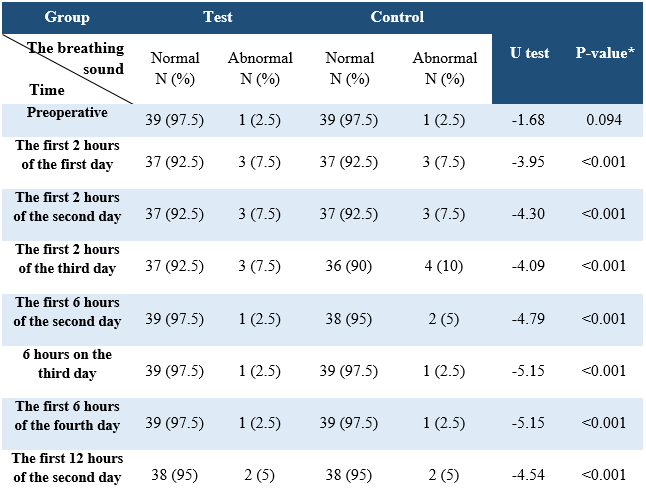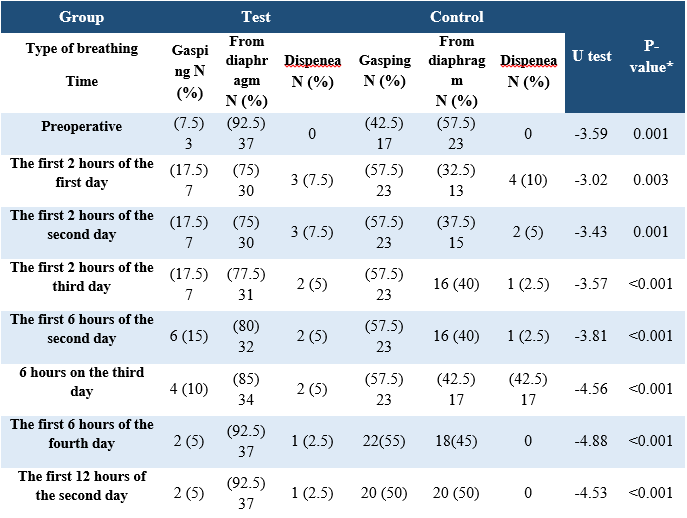BibTeX | RIS | EndNote | Medlars | ProCite | Reference Manager | RefWorks
Send citation to:
URL: http://nmj.umsha.ac.ir/article-1-2039-en.html


 , Atefeh Bostanbakhsh2
, Atefeh Bostanbakhsh2 
 , Mohsen Salavati *3
, Mohsen Salavati *3 
 , Mohammad Bakhsai4
, Mohammad Bakhsai4 
 , Abas Moghimbeighi5
, Abas Moghimbeighi5 
 , Zahra Maghsoudi6
, Zahra Maghsoudi6 

2- Master of Nursing, Student Research Committee, School of Nursing and Midwifery, Hama- dan University of Medical Sciences, Hamadan, Iran
3- Instructor, School of Nursing and Midwifery, Hamadan University of Medical Sciences, Hamadan, Iran ,
4- Associate Professor, Department of Anesthesiology, School of Medicine, Hamadan University of Medical Sciences, Hamadan, Iran
5- Department of Biostatistics, School of Health, Hamadan University of Medical Sciences, Hamadan, Iran
6- PhD Student in Nursing, Student Research Committee, Hamadan University of Medical Sciences, Hamadan, Iran
✅ This study showed that breathing exercises can reduce the incidence of atelectasis. Therefore, applying this method as a routine care is recommended in patients with CAB surgery.
Coronary artery bypass surgery is the treatment of choice for many patients with coronary artery disease, with more than one million coronary artery bypass grafts performed annually [1, 2]. Patients undergoing coronary artery bypass grafting are at increased risk of pulmonary complications [3, 4]; Atelectasis with a prevalence of 27-95% is the most common pulmonary complication after coronary artery bypass graft surgery [6, 7].
Measures to improve pulmonary function after coronary artery bypass surgery may include chest physiotherapy, effective catheterization, deep breathing exercises, motivational spirometry, intermittent or continuous positive pressure, spontaneous nebulization, and nebulizer use [11, 13].
Much research has been done on the effectiveness of breathing exercises, but their results vary widely [3, 16-19]. Therefore, this study was performed to determine the effect of breathing exercises on the incidence of atelectasis in patients undergoing coronary artery bypass graft surgery.
The present study is a clinical trial with a control group, registered in Iran clinical trial site with code IRCT201112188451N1. The study population included all patients undergoing coronary artery bypass graft surgery in Ekbatan Hospital, Hamadan, the only cardiac surgery center in Hamadan between 2013-2014. In this study, 80 patients were selected by purposive sampling and met the inclusion criteria. After receiving informed and written consent, they were randomly divided into two experimental and control groups (40 patients each).
Inclusion criteria included being candidate for coronary artery bypass graft surgery, 45-65 years old, normal pulmonary function test, absence of acute and chronic pulmonary disease, and normality of thoracic cavity. Patients who needed to return to the operating room or needed endotracheal intubation during the study, as well as patients with unwanted postoperative complications (pneumothorax, pulmonary embolism, adrenal, emphysema, pleural effusion, advanced pulmonary infection) or their surgical procedure was more than usual (up to 5 hours), were excluded.
In test group (n=40), respiratory exercises (30 deep respiratory per hour for 3 days postoperatively) were performed by patients, after full education and extubation along with routine care. In control group (n=40), patients only received routine care. Chest x ray was used to diagnose atelectasis.
Data were analyzed by SPSS 17 (SPSS Inc. Chicago, Illinois, USA) using descriptive statistics (mean and standard deviation) and nonparametric Mann-Whitney tests (to determine and compare mean data between groups) and Friedman (in order to determining the difference between different time points in one group). Statistical significance was set at P-value <0.05.
The two groups did not differ significantly in terms of personal characteristics such as age, sex, education, body mass index (BMI) and etc. (P<0/05) (Table 1). The result of the Mann-Whitney test in order to compare the two groups of test and control for the occurrence of atelectasis, respiration and respiratory type showed a significant difference between the two groups at all hours after surgery (P<0/001). These findings confirmed the effectiveness of respiratory exercises (Tables 2, 3 and 4).
Table 1. Demographic characteristics in two groups of test and control

Table 2. Comparison of atelectasis between experimental and control groups at different hours (based on lung radiographic report)


Table 3. Comparison of respiratory noise between the test and control groups at different times


Table 4. Comparison of the type of breathing between the test and control groups at different times


The results of this study showed that breathing exercises, including deep breathing, effective perforation and use of motivational spirometry, were more effective in reducing atelectasis after coronary artery bypass grafting compared to routine hospital performance. This finding is in line with the study by Shaban et al., which suggests that pre-operative breathing exercise reduces the incidence of atelectasis and improves ventilation status [22].
This study showed that breathing exercises can reduce the incidence of atelectasis. Therefore, applying this method as a routine care is recommended in patients with CAB surgery.
This article is part of a Master's Degree in Nursing with Code of Ethics 2854/35/16 / BC / 9109073200 Approval Code approved by Hamadan University of Medical Sciences. The researchers would like to express their gratitude to Hamadan University of Medical Sciences for their financial support, to Ekbatan Hospital staff for their contribution in the research, and to the respected patients for participating in this study.
The authors declared no conflict of interest regarding the publication of this article.
Received: 2019/05/20 | Accepted: 2019/07/14 | Published: 2019/08/28
| Rights and permissions | |
 |
This work is licensed under a Creative Commons Attribution-NonCommercial 4.0 International License. |




 gmail.com
gmail.com